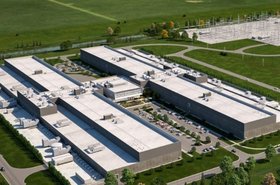Experienced data center builders can deliver hyperscale facilities for $6 million per MW of power, while some are achieving costs as low as $3.6 million per MW, DCD's Building at Scale conference heard today.
The increase in cloud services has made for a huge demand for data centers, but hyperscale customers expect to pay less for their facilities, putting pressure on data center providers, according to Rhonda Ascierto, VP of research at Uptime Institute. Some of the best results have come from China, while the well-developed data center hubs in the US have managed to get provisioning costs down low.
In future, as the big data center providers grow ever larger, there is a possibility that the costs and timescales can be further improved on, she said.
Building big and fast
"There has been a revolution in data center construction over the past decade," said Ascierto in the keynote presentation. "The explosive growth of large data centers in recent years has been accompanied and made possible by extraordinary advances in engineering particularly in the field of provisioning."
For large "hyperscale" data centers, bigger than 20MW, wholesale data center providers are now aiming to meet a best-practice goal of building them as in six months or less, for as little as $6 million per MW, according to Uptime research, although the average round the world for such projects is now at between $7m and $8m per MW. Medium data centers between 5MW and 19.9MW can achieve the same speed and cost, but the average cost there is between $8m and $9m per MW.
Uptime's research looked at data center projects which were active between 2017 and 2019, said Ascierto, defining the completion of the project as the moment when the building and its power and cooling were complete -before the servers, switches and cables are installed.
To achieve these costs and timescales, providers use very standardized builds and equipment, and pre-order a pipeline of equipment such as generators and switchgear which could delay otherwise the project. The best times and costs are achieved when the ground is already approved for building, there is no major piling or groundwork required, and power and fiber is available.
The use of prefabricated equipment reduces the time spent on site, she said: for instance, if prefabricated "skids" of power equipment and gensets arrive having been pre-tested at the factory, all that is required onsite is integrated systems testing. Aiming for a high rack power density can also reduce build costs, as the same compute capacity power can be delivered in a smaller floor space, at a proportionally lower building cost.
There's a big variation, however in these costs, sometimes even within a single country, said Ascierto: "Some of the fastest builds and the lowest costs were in North American data center hubs. The path has already been trod, there are highly industrialized sup[ply chains in place."
However, Asian markets benefit from low labor and construction costs, and also the proximity of manufacturing plants where equipment is made: "A Beijing-based company is achieving average capex of $3.6 million per MW," she said, thanks to access to manufacturing in the region.
"This is a significant improvement over 10 years ago, when $12 million per MW was not uncommon," she said, but it is not the end of the story., with a possibility that costs and build times could be driven down even further: "It's fair to assume that major wholesalers and colos are likely to only get even bigger. With that increase in size, they may have a greater stretch across the supply chain, and even stronger control of various factors."
Building at Scale continues on 9 and 10 July, and will be available free on demand.




